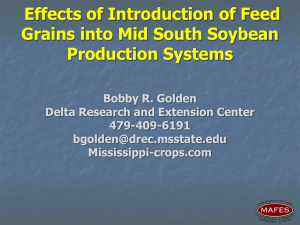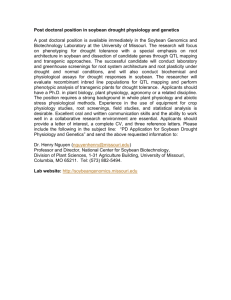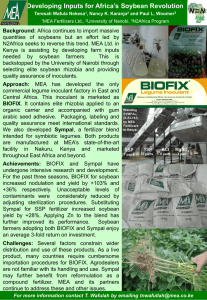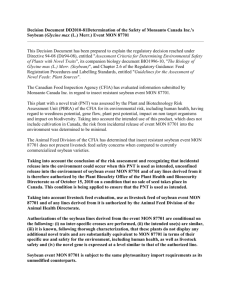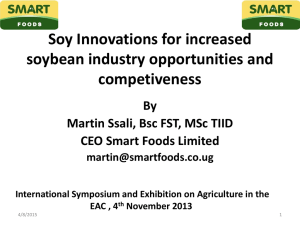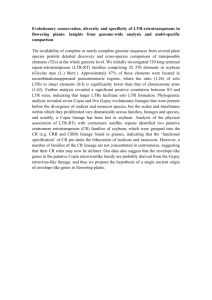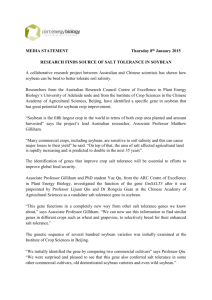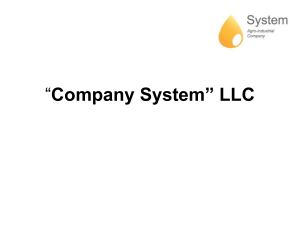emi12497-sup-0001-si
advertisement
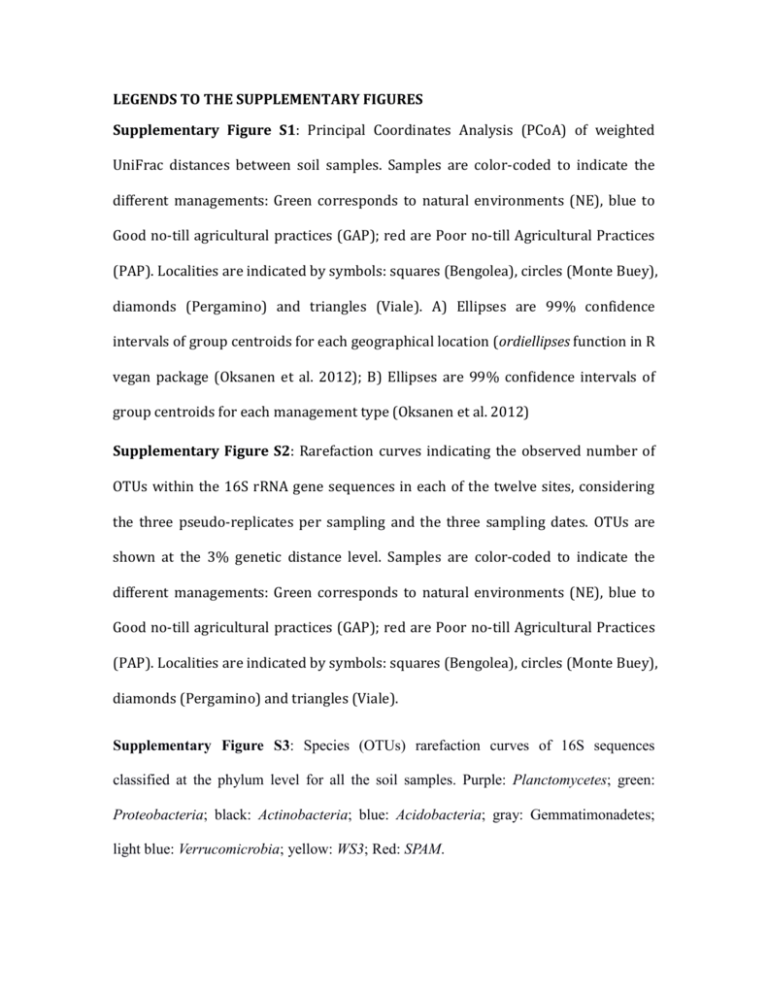
LEGENDS TO THE SUPPLEMENTARY FIGURES Supplementary Figure S1: Principal Coordinates Analysis (PCoA) of weighted UniFrac distances between soil samples. Samples are color-coded to indicate the different managements: Green corresponds to natural environments (NE), blue to Good no-till agricultural practices (GAP); red are Poor no-till Agricultural Practices (PAP). Localities are indicated by symbols: squares (Bengolea), circles (Monte Buey), diamonds (Pergamino) and triangles (Viale). A) Ellipses are 99% confidence intervals of group centroids for each geographical location (ordiellipses function in R vegan package (Oksanen et al. 2012); B) Ellipses are 99% confidence intervals of group centroids for each management type (Oksanen et al. 2012) Supplementary Figure S2: Rarefaction curves indicating the observed number of OTUs within the 16S rRNA gene sequences in each of the twelve sites, considering the three pseudo-replicates per sampling and the three sampling dates. OTUs are shown at the 3% genetic distance level. Samples are color-coded to indicate the different managements: Green corresponds to natural environments (NE), blue to Good no-till agricultural practices (GAP); red are Poor no-till Agricultural Practices (PAP). Localities are indicated by symbols: squares (Bengolea), circles (Monte Buey), diamonds (Pergamino) and triangles (Viale). Supplementary Figure S3: Species (OTUs) rarefaction curves of 16S sequences classified at the phylum level for all the soil samples. Purple: Planctomycetes; green: Proteobacteria; black: Actinobacteria; blue: Acidobacteria; gray: Gemmatimonadetes; light blue: Verrucomicrobia; yellow: WS3; Red: SPAM. Supplementary Figure S4: Histograms of pairwise phylogenetic distances for major phyla, between soils samples from within each soil management type. Distributions are color-coded to indicate the different managements: Green corresponds to natural environments (NE), blue to Good no-till agricultural practices (GAP); red are Poor no-till Agricultural Practices (PAP). A 0 . 0 0 VIA MB PE −0 . 0 5 B −0 . 1 0 PCoA 2 0 . 0 5 0 . 1 0 Supplementary Figure S1 −0 . 2 −0 . 1 0 . 0 PCoA 1 0 . 1 0 . 1 0 0 . 0 0 PAP NE GAP −0 . 1 0 −0 . 0 5 PCoA 2 0 . 0 5 B −0 . 2 −0 . 1 0 . 0 PCoA 1 Supplementary Figure S2 0 . 1 Supplementary Figure S3 Number of OTUs 3,000 2,000 1,000 0 0 10,000 20,000 30,000 Number of sequences 40,000 Supplementary Figure S4 Supplementary Figure S4 (cont) Supplementary Table S1: Measures of α-diversity and pairwise statistics between different soil managements Good no-till Agricultural Practices Poor no-till Agricultural Practices Richness (R)1 580 ± 13 563 ± 13 Shannon (H)1 5.69 ± 0.03 5.60 ± 0.04 Diversity Index 1 2 NE vs GAP PAP vs GAP NE vs PAP p value2 p value2 p value2 568 ± 13 0.4 0.3 0.7 5.64 ± 0.04 0.4 0.2 0.6 Natural Environments Indices and standard errors are least square estimates from LMM P values were obtained from F statistics (Satterthwaite approximation to denominator DOF) with difflsmeans in lmer test, which tested the null hypothesis that means were not significantly different between soil mangements Supplementary Table S2: Sequence of crops practiced from 2000 to 2011 in the eight agricultural sites examined in this study. PAP refers to the operational definition of Poor no-till Agricultural Practices; GAP refers to Good no-till Agricultural Practices Location/Year 2000/2001 2001/2002 2002/2003 2003/2004 PAP Bengolea N/A N/A N/A N/A PAP Monte Buey Soybean * PAP Pergamino N/A N/A PAP Viale N/A N/A GAP Bengolea Corn Soybean Wheat/Soybean Corn Corn Wheat/Soybean GAP Monte Buey Wheat/Soybean GAP Pergamino N/A GAP Viale Corn Wheat/soybean N/A Wheat/Soybean 2004/2005 2005/2006 2006/2007 Wheat * Soybean * Soybean Corn Soybean Soybean Wheat/soybean Corn N/A N/A Soybean Soybean Soybean Corn Soybean Wheat/Soybean Wheat/Soybean Corn Wheat/Soybean Corn Wheat/Sorghum Corn Wheat/Soybean N/A Soybean Wheat/Soybean Corn Wheat/Soybean Ryegrass/Corn Soybean Soybean N/A Corn Wheat/Soybean Soybean Supplementary Table S2 (cont) Location/Year 2007/2008 PAP Bengolea 2008/2009 2009/2010 2010/2011 Wheat/Soybean Soybean Corn Soybean PAP Monte Buey Soybean Soybean Soybean Wheat/soybean PAP Pergamino Soybean Soybean Soybean Soybean PAP Viale Corn Soybean Soybean Wheat/Soybean GAP Bengolea Vicia/Corn Wheat/Soybean Soybean GAP Monte Buey Vicia/Corn Corn GAP Pergamino Soybean Wheat/Soybean Corn GAP Viale Wheat/Soybean Corn N/A: Data not available * Managed under conventional tilling Corn Wheat/Soybean Vicia/Corn Soybean Soybean Corn Suppl. Appendix S1: Mixed effect linear models. Proposed full models containing agricultural practice as fixed factor and site, sampling, sample and all possible interactions as random effects. Reduced models derived from automatic backward elimination of non-significant effects. 1. MEAN NEAREST TAXON DISTANCE Full model: fm1= lmer(mntd.obs ~ Land Use +(1|Land Use:Site)+(1|Sampling:Site)+(1|Land Use:Sampling)+(1|Sample:Sampling)+(1|Sample:Site)+(1|Land Use:Sample)+(1|Site)+(1|Sample)+(1|Sampling),data=tabla) Reduced model: rm1=lmer(mntd.obs ~ Land Use + (1 | Land Use:Sample) + (1 | Site) 2. WIDELY DISTRIBUTED AND ENDEMIC Taxa a. Endemic Taxa Full model: fm2= lmer(Endemic ~ Land Use +(1|Land Use:Site)+(1|Sampling:Site)+(1|Land Use:Sampling)+(1|Sample:Sampling)+(1|Sample:Site)+(1|Land Use:Sample)+(1|Site)+(1|Sample)+(1|Sampling),data=tabla) Reduced model: rm2=lmer( Endemic ~ Land Use + (1 | Land Use:Sample) + (1 | Site) + (1 | Sampling), data = tabla) b. Widely distributed Taxa Full model: fm3=lmer(Widely ~ Land Use +(1|Land Use:Site)+(1|Sampling:Site)+(1|Land Use:Sampling)+(1|Sample:Sampling)+(1|Sample:Site)+(1|Land Use:Sample)+(1|Site)+(1|Sample)+(1|Sampling),data=tabla) Reduced model: rm3=lmer(Widely ~ Land Use + (1 | Sample:Sampling) + (1 | Site), data = tabla) (1 | Land Use:Sample) + 3. α diversity a. Richness Full model: fm4= lmer(Taxa ~ Land Use +(1|Land Use:Site)+(1|Sampling:Site)+(1|Land Use:Sampling)+(1|Sample:Sampling)+(1|Sample:Site)+(1|Land Use:Sample)+(1|Site)+(1|Sample)+(1|Sampling),data=tabla) Reduced model: rm4= lmer(Taxa ~ Land Use + (1 | Land Use:Site) + (1 | Sampling), data = tabla) b. Shannon Index Full model: fm5= lmer(Shannon_H~ Land Use +(1|Land Use:Site)+(1|Sampling:Site)+(1|Land Use:Sampling)+(1|Sample:Sampling)+(1|Sample:Site)+(1|Land Use:Sample)+(1|Site)+(1|Sample)+(1|Sampling),data=tabla) Reduced model: rm5=lmer(Shannon_H ~ Land Use + (1 | Land Use:Site), data = tabla) Reference Oksanen, J., Blanchet, F.G., Kindt, R., Legendre, P., Minchin, R.B., O’Hara, R.B. et al. (2012). vegan: Community Ecology Package. R Package version 2.0-5. Available at: http://CRAN.R-project.org/package=vegan

